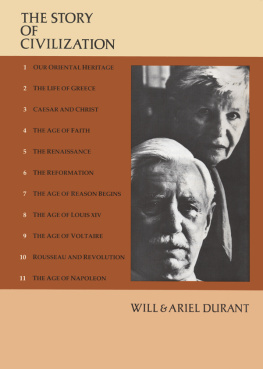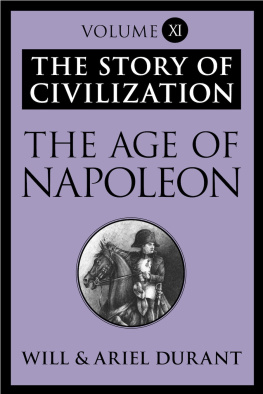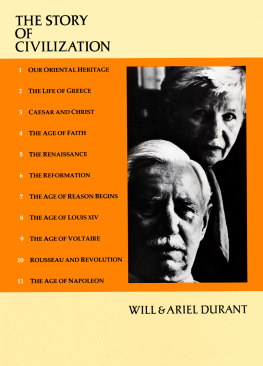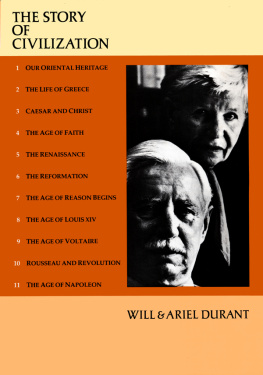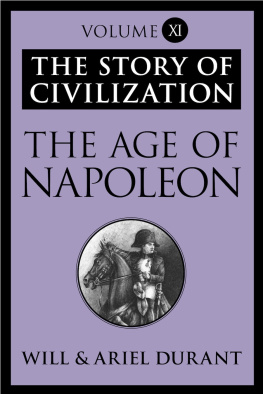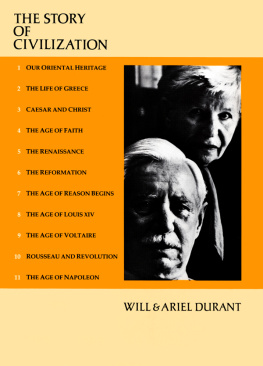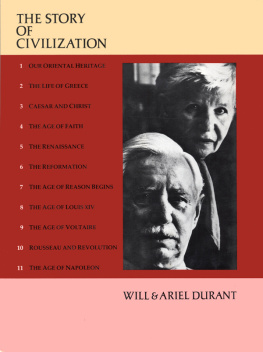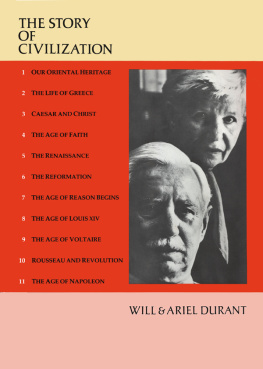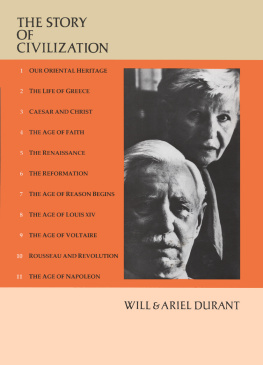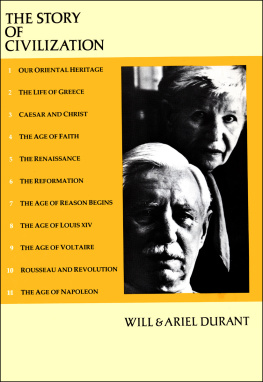
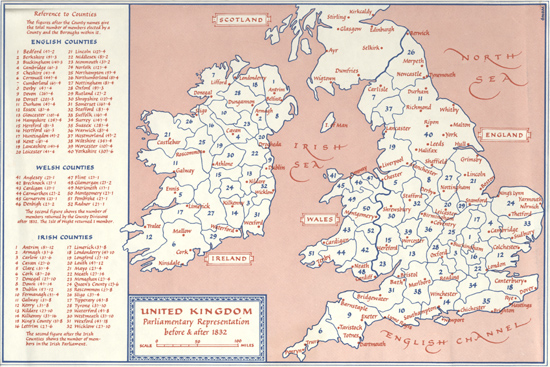
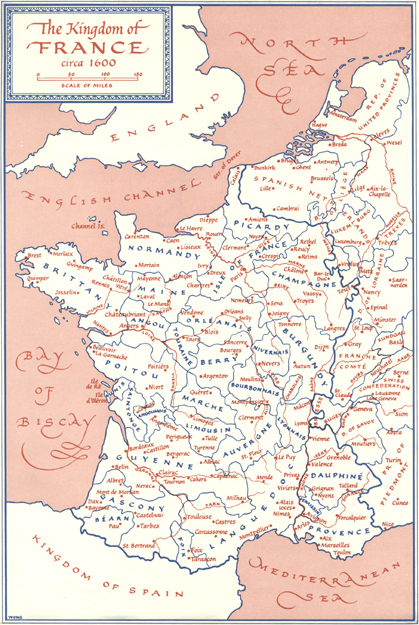
BY WILL DURANT
The Story of Philosophy
Transition
The Pleasure of Philosophy
Adventures in Genius
BY WILL AND ARIEL DURANT
THE STORY OF CIVILIZATION
1. Our Oriental Heritage
2. The Life of Greece
3. Caesar and Christ
4. The Age of Faith
5. The Renaissance
6. The Reformation
7. The Age of Reason Begins
8. The Age of Louis XIV
9. The Age of Voltaire
10. Rousseau and Revolution
11. The Age of Napoleon
The Lessons of History
Interpretation of Life
A Dual Autobiography

COPYRIGHT 1963 BY WILL AND ARIEL DURANT
ALL RIGHTS RESERVED
INCLUDING THE RIGHT OF REPRODUCTION
IN WHOLE OR IN PART IN ANY FORM
PUBLISHED BY SIMON AND SCHUSTER
A DIVISION OF GULF & WESTERN CORPORATION
SIMON & SCHUSTER BUILDING
ROCKEFELLER CENTER
1230 AVENUE OF THE AMERICAS
NEW YORK, NEW YORK 10020
www.SimonandSchuster.com
SIMON AND SCHUSTER AND COLOPHON ARE TRADEMARKS
OF SIMON & SCHUSTER
ISBN 0-671-01215-0
eISBN 978-1-4516-4765-5
LIBRARY OF CONGRESS CATALOG CARD NUMBER 3510016
MANUFACTURED IN THE UNITED STATES OF AMERICA
TO OUR BELOVED
GRANDDAUGHTER
MONICA
Dear Reader:
T HIS volume is Part VIII in a history whose beginning has been forgotten, and whose end we shall never reach. The subject is civilizazation, which we define as social order promoting cultural creation; therefore it includes government, economy (agriculture, industry, commerce, finance), morality, manners, religion, art, literature, music, science, and philosophy. The aim is integral historyto cover all phases of a peoples activity in one perspective and one unified narrative; that aim has been very imperfectly achieved. The scene is Europe. The time is from the Treaty of Westphalia (1648) to the death of Louis XIV, whose reign (16431715) dominated and named the age.
The pervading theme is the Great Debate between faith and reason. Faith was on the throne in this period, but reason was finding new voices in Hobbes, Locke, Newton, Bayle, Fontenelle, and Spinoza; this Classical Age was throughout what it called itself at its close, the Age of Reason. Almost a third of the book is devoted to the Intellectual Adventure out of superstition, obscurantism, and intolerance to scholarship, science, philosophy. An attempt is made to report the discussion fairly, despite the authors evident prejudice; hence the extended and sympathetic treatment of such able defenders of the faith as Pascal, Bossuet, Fnelon, Berkeley, Malebranche, and Leibniz. Our children will live a new chapter in this conflict of ideals, where every victory must be repeatedly rewon.
We hope to present Part IX, The Age of Voltaire, in 1965, and Part X, Rousseau and Revolution, in 1968. Some difficulties have arisen, partly from the wealth of material offered by the eighteenth century, all demanding study and space. Meanwhile we shall rely on the Great Powers not to destroy our subject before it destroys us.
May, 1963
WILL AND ARIEL DURANT
ACKNOWLEDGMENTS
One of the associated publishers with whom we began this word business in 1926 has passed away; we shall never forget his bright spirit. The other is still our friend, always enthusiastic, generous, and forgiving, a publisher who remains a poet.
We trust that it will not be interpreted as a lively sense of future favors if we take thiswhich could be our lastchance to express our gratitude to the many critics who have won us an audience for these volumes. Without their help we should have been voices moaning in the wilderness.
We owe a substantial debt to our daughter Ethel for her devoted transformation of our not quite legible second draft into an almost perfect typescript, with wise emendations. And to our sisters and brotherSarah, Flora, Mary, and Harry Kaufmanfor their patient classification of some forty thousand notes under some twelve thousand headings. To Mrs. Anne Roberts of the Los Angeles Public Library, and Miss Dagny Williams of the Hollywood Regional Library, for their precious aid in securing rare books from all over America; these volumes could never have been written without our magnificent, open-handed libraries. And to Mrs. Vera Schneider, of the editorial staff of Simon and Schuster, for such scholarly editing of this and the preceding volume as probably few manuscripts have ever received.
Albert Gurard, The Life and Death of an Ideal, p. 18.
NOTES ON THE USE OF THIS BOOK
1. Dates of birth or death have usually been omitted from the narrative, where they tend to be forgotten or lost; they will be found always available in the Index.
2. The value of coins in any age is subject to so many influences and variations that no reliable system can be set up for equating them with current currencies. The livre in this period sank in value to the level of a franc. Voltaire reported this would make a shilling equal to $2.50. From such comparisons we derive the following hazardous and loose equivalents:
crown, $12.50
ducat, $12.50
cu, $8.00
florin, $12.50
franc, $2.50
guinea, $52.50
guilder, $10.50
gulden, $10.50
livre, $2.50
louis dor, $50.00
mark, $30.00
penny, $.21
pound, $50.00
reale, $.50
ruble, $10.00
scudo, $1.16
shilling, $2.50
sou, $.15
thaler, $8.00
3. The location of works of art, when not indicated in the text, will usually be found in the Notes. In allocating such works the name of the city will imply its leading gallery, as follows:
AmsterdamRijksmuseum
BerlinStaatsmuseum
BolognaAccademia di Belle Arti
BrusselsMuseum
BudapestMuseum of Fine Arts
CasselMuseum
ChantillyMuse Cond
ChatsworthDuke of Devonshire Collection
ChicagoArt Institute
CincinnatiArt Institute
ClevelandMuseum of Art
DetroitInstitute of Art
DresdenGemlde-Galerie
DulwichCollege Gallery
EdinburghNational Gallery
FerraraGalleria Estense
FrankfurtStdelsches Kunstinstitut
GenevaMuse dArt et dHistoire
HaarlemFrans Hals Museum
The HagueMauritshuis
Kansas CityNelson Gallery
LeningradHermitage
LisbonNational Museum
LondonNational Gallery
MadridPrado
MilanBrera
MinneapolisInstitute of Arts
MunichHaus der Kunst
NaplesMuseo Nazionale
New YorkMetropolitan Museum of Art
NurembergGermanisches Nationalmuseum
PhiladelphiaJohnson Collection
RouenMuse Municipale
St. LouisArt Museum
San DiegoFine Arts Gallery
San FranciscoDe Young Museum
San Marino, Calif.Henry E. Huntington Art Gallery
Sarasota, Fla.Ringling Museum of Art
SevilleArt Museum
StockholmNational Museum
ViennaKunsthistorisches Museum
WashingtonNational Gallery
4. Reduced type has occasionally been used to indicate passages of only remote or special interest, or exceptionally dull.
Next page
